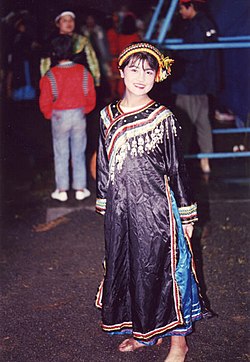This article has multiple issues. Please help improve it or discuss these issues on the talk page . (Learn how and when to remove these messages)
|
Indigenous peoples [a] are non-dominant people groups descended from the original inhabitants of their territories, especially territories that have been colonized. [1] [2] [3] The term lacks a precise authoritative definition, [4] [3] [5] although in the 21st century designations of Indigenous peoples have focused on self-identification, cultural difference from other groups in a state, a special relationship with their traditional territory, and an experience of subjugation and discrimination under a dominant cultural model. [6]
Contents
- Definition
- Africa
- African Great Lakes
- Central Africa
- Horn of Africa
- Sudan
- Southern Africa
- West Africa
- North Africa
- West and Central Asia
- West Asia
- Central Asia
- South Asia
- Indian subcontinent
- Andaman and Nicobar Islands
- Northeast Asia
- China
- Mongolia
- Taiwan
- Japan
- Korea
- Siberia and Far East of Russia
- Southeast Asia
- Mainland Southeast Asia (Indochina Peninsula)
- Maritime Southeast Asia (Malay Archipelago)
- Europe
- Northern Europe
- Western Europe
- Americas
- North America
- Central America
- South America
- Caribbean
- Oceania
- Australia
- Melanesia
- Micronesia
- Polynesia
- Circumpolar
- See also
- References
- Notes
- Citations
- Sources
Estimates of the population of Indigenous peoples range from 250 million to 600 million. [7] There are some 5,000 distinct Indigenous peoples spread across every inhabited climate zone and inhabited continent of the world. [8] [9] Most Indigenous peoples are in a minority in the state or traditional territory they inhabit and have experienced domination by other groups, especially non-Indigenous peoples. [10] [11] Although many Indigenous peoples have experienced colonization by settlers from European nations, [12] Indigenous identity is not determined by Western colonization. [6]
The rights of Indigenous peoples are outlined in national legislation, treaties and international law. The 1989 International Labour Organization (ILO) Convention on Indigenous and Tribal Peoples protects Indigenous peoples from discrimination and specifies their rights to development, customary laws, lands, territories and resources, employment, education and health. [13] In 2007, the United Nations (UN) adopted a Declaration on the Rights of Indigenous Peoples including their rights to self-determination and to protect their cultures, identities, languages, ceremonies, and access to employment, health, education and natural resources. [14]
Indigenous peoples continue to face threats to their sovereignty, economic well-being, languages, cultural heritage, and access to the resources on which their cultures depend. [15] In the 21st century, Indigenous groups and advocates for Indigenous peoples have highlighted numerous apparent violations of the rights of Indigenous peoples.


























































































